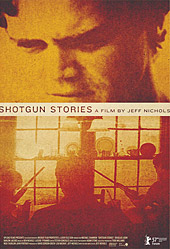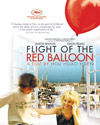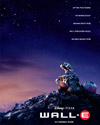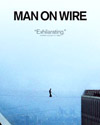Return to Response
Return to Response OnScreen Archive
An Oscar Do-Over
Five movies that might have been better than the Academy's "Best Picture" picks
It’s all part of the tradition. Before the Oscars, we complain about what was nominated and what was left out.
But for this film enthusiast, 2009 is the first Oscar ceremony in which all five nominees for Best Picture inspire no enthusiasm whatsoever. It was a year full of memorable, inspiring, artistic films, but none of those that moved me most, or those that topped the surveys of critics across the country, made it into this batch of honorees.
So take this for what it is — one moviegoer’s opinion, based on far too many hours of reviewing, reviewing, and revisiting the movies of 2008.
 SHOTGUN STORIES, Instead of Frost/Nixon SHOTGUN STORIES, Instead of Frost/Nixon
Frost/Nixon focuses on a famously disgraced American president. The performances are engaging, but director Ron Howard — a master of oversimplification and calculated entertainment — manages to oversimplify Nixon’s role in our country’s history, claiming that his only legacy was a story of failure and betrayal. Wouldn’t it be better if films about Nixon drew us into greater understanding, acknowledging him as a complex human being of failures, but also of strengths? Was the suffix “-gate” really the only legacy he left behind? Was the confession really a spontaneous collapse, or was it a strategy? Did he do nothing more than commit a crime? Rather than throwing fuel on the fires of contempt, how about encouraging us toward real insight?
Shotgun Stories, by contrast, shows us a whole community of complicated people prone to error and crimes of passion. Instead of praising “Good Guys” and scorning “Bad Guys,” it takes a hard look at what reconciliation and healing might be possible for everyone involved. There are no villains in this story, only fractured people who will destroy each other if they don’t learn from their mistakes. This is a film that treats viewers as if we are capable of thinking through messy human complexity on our own.
Director Jeff Nichols’ debut is a riveting tale of an Arkansas family feud. It begins at a funeral, where a pastor consoles a Christian family that has lost a faithful husband and father. But then three young men show up to disrupt the ceremony. They are Son, Boy, and Kid — the sons of another mother, abandoned to poverty and trouble by the deceased many years earlier. Son’s comments about their father’s irresponsibility and neglect spark a row, and soon the first and second families are at war.
While Nichols’ film is convincingly specific in its context, it has the timeless quality of an Old Testament story, and explores difficult questions about how to end ongoing cycles of violence. The world needs movies peacemaking and reconciliation right now — and this film serves as a brilliant example. Actor Michael Shannon, Oscar-nominated for his role in Revolutionary Road, gives a powerful performance in the lead role here.
(For more on Shotgun Stories, read Overstreet's commentary published at Good Letters, the daily blog for Image journal.)
FLIGHT OF THE RED BALLOON, Instead of The Reader
 If films focus on heavy, ponderous themes like the Holocaust, they’re likely to be nominated for Best Picture. If they are also focused on cultivating sympathy for adults who behave very badly, they’re also likely to win praise. Films that focus on levity and wonder, films that reveal the wondrous in the ordinary — those films are usually forgotten at Oscar time. The Reader is about a woman whose ignorance leads to her participation in an atrocity. It’s also about how she finds solace in sex with a much, much younger man. While the story is not without merit, was there no better film about the loss of innocence than this? If films focus on heavy, ponderous themes like the Holocaust, they’re likely to be nominated for Best Picture. If they are also focused on cultivating sympathy for adults who behave very badly, they’re also likely to win praise. Films that focus on levity and wonder, films that reveal the wondrous in the ordinary — those films are usually forgotten at Oscar time. The Reader is about a woman whose ignorance leads to her participation in an atrocity. It’s also about how she finds solace in sex with a much, much younger man. While the story is not without merit, was there no better film about the loss of innocence than this?
By contrast, master filmmaker Hou Hsiao-Hsien’s film Flight of the Red Balloon is about the contrast between the wonder of childhood and the burden of adulthood is profoundly poetic and thoughtful-provoking. It contrasts a day in the life of a stressed-out workaholic (Juliette Binoche) and her wide-eyed son.
With a show of gratitude to Albert Lamorisse for his children’s classic The Red Balloon, Hou lets the camera wander, drifting like a balloon on the breeze, or like a child through a wonderland. Plot is secondary to exploration here, and his patient observation allows us the pleasure of discovering people who are as complex and beautiful as the world they inhabit.
When the website indieWire surveyed almost 200 film critics, they voted this as their favorite film of the year. The Academy failed to notice. It’s a gift to moviegoers, and it also happens to be a more thought-provoking study of youth and aging than another Oscar contender, The Curious Case of Benjamin Button (see below).
RACHEL GETTING MARRIED, Instead of Slumdog Millionaire
 Slumdog Millionaire is being praised as an inspiring, energetic cultural experience. It’s a powerful, exhilarating film — make no mistake. And yet, while I was glad to see the film’s detailed depiction of poverty in India’s slums, I found it difficult to care much about its central storyline — in which a boy chases his dream girl for years. The conclusion — full of love and money — felt disappointing, considering the severity of the suffering and despair we saw throughout the movie. The simplistic storyline moved too fast for us to really get to know its characters. Slumdog Millionaire is being praised as an inspiring, energetic cultural experience. It’s a powerful, exhilarating film — make no mistake. And yet, while I was glad to see the film’s detailed depiction of poverty in India’s slums, I found it difficult to care much about its central storyline — in which a boy chases his dream girl for years. The conclusion — full of love and money — felt disappointing, considering the severity of the suffering and despair we saw throughout the movie. The simplistic storyline moved too fast for us to really get to know its characters.
Personally, I found a much richer story, and a much more interesting cultural experience, one that offered much more substantial hope, watching Jonathan Demme’s new film Rachel Getting Married. Demme, best known for his horrifying thriller The Silence of the Lambs, offers us an experience full of real redemption. Even if the family at its center is badly broken and prone to profane outbursts and mean-spirited clashes, they are complicated, three-dimensional characters.
Set on the weekend of a wedding, while people from many cultures and various walks of life converge for a communal celebration, Kym (Ann Hathaway) returns to her family after a long struggle in rehab. Kym is seeking understanding, compassion, and patience, but her presence stirs up all kinds of trouble for her father and her soon-to-be-married sister Rachel (Rosemarie Dewitt). While this multicultural gathering may be a bit idealistic, their shared experiences of trials, troubles, and joys is an event of vivid colors and powerful emotions. It’s a cliché to say “You’ll laugh, you’ll cry,” but it’s true. This film is tough, but it’s also radiant with life.
WALL-E, Instead of The Curious Case of Benjamin Button
 In The Curious Case of Benjamin Button, we watch Brad Pitt’s character age backward. But other than the spectacular digital effects, what is it about this character that’s so interesting? Benjamin is so inert, so lifeless. He just follows people around and does what they tell him. He’s just along for the ride, and it is a very, very long ride. Does the film really have much insight to offer? For me, it was a curious case of Benjamin boredom. In The Curious Case of Benjamin Button, we watch Brad Pitt’s character age backward. But other than the spectacular digital effects, what is it about this character that’s so interesting? Benjamin is so inert, so lifeless. He just follows people around and does what they tell him. He’s just along for the ride, and it is a very, very long ride. Does the film really have much insight to offer? For me, it was a curious case of Benjamin boredom.
Meanwhile, another film full of fantastic animation really inspired me — and many other moviegoers as well. When critics across the country turned in their top 10 lists for 2008, many of them put WALL-E at the top — a G-rated, animated Pixar movie designed for viewers from the ages of 5 to 95. That fact alone should have made the Academy pay attention.
What’s so special about WALL-E? Andrew Stanton’s story is an imaginative fusion of Noah’s Ark and 2001: A Space Odyssey. It affirms that human beings are at their best when reaching for something contrary to their programming — love. And it gives us a sharp Swiftian satire of contemporary life, in which humanity has become enslaved to “mechanical” instincts and instant gratification. It takes an inspired robot, one who has become more human than the humans who abandoned him, to remind us by example that we are designed to transcend those impulses, to look beyond ourselves and reach for the sublime. How ironic, then, that this superb work of imagination, comedy, and heart was produced on computers!
But the Academy apparently thinks that cartoons aren’t to be taken seriously as art, and shoved WALL-E aside into the Best Animated Feature category. They seem to have overlooked the fact that Benjamin Button has received so much digital processing, it might as well be classified as an “animated feature” as well.
MAN ON WIRE, Instead of Milk
 In Milk, a rather conventional “biopic” from Gus Van Sant, Sean Penn plays human rights activist Harvey Milk. His powerful performance is earning praise, and the movie is inspiring people to consider what is possible when a person rises to a challenge and resists persecution. Whatever your views on homosexual rights, Milk’s story can be a sobering reminder of the destructive power of hatred and prejudice. In Milk, a rather conventional “biopic” from Gus Van Sant, Sean Penn plays human rights activist Harvey Milk. His powerful performance is earning praise, and the movie is inspiring people to consider what is possible when a person rises to a challenge and resists persecution. Whatever your views on homosexual rights, Milk’s story can be a sobering reminder of the destructive power of hatred and prejudice.
But the film reportedly focuses on only Milk’s more admirable qualities, and carefully erases some of his more questionable behavior. If so, this is dishonest, and does viewers a disservice.
Personally, I’m far more inspired by the unlikely story of Philippe Petit in the documentary called Man on Wire. Petit, a circus performer and daredevil, was only 24 when he spent 45 minutes dancing on a high wire strung between the towers of the World Trade Center in August of 1974. The story of his remarkable feat is, yes, the story of a crime. But it is also a story of what is possible when we have faith, vision, and courage.
We meet the unique characters who combined their criminal minds to achieve a seemingly impossible act of “harmless” beauty. We watch them draw up their meticulous plans and practice for the big day. And then we watch, breathless, as they risk their lives to fulfill their dreams.
The fact that the entire film plays out without a single mention of September 11, 2001, without any comment whatsoever on the fact that the towers aren’t there anymore, is itself a high-wire act. The filmmakers navigate treacherous emotional territory. It’s hard to imagine how it might have felt to watch this film before the towers fell. But seeing it now, as I took in views of those towers from every angle … even looking down from the air halfway between them … I was deeply, strangely moved. The filmmakers have done a powerfully redemptive work here by training us to look at the WTC again and see those monoliths as thrilling, as a monument to vision, as a stage for a grand drama of ambition and art.
If all of us had even half of Philippe Petit’s faith, and applied such willpower to change the world in ways both brilliant and beautiful, anything would be possible.
And One More
While the film is arriving late in America, Laurent Cantet’s The Class is the most inspiring tribute to an educator I have ever seen on film. It’s a drama about a high school teacher who must contend with a classroom full of rowdy students who challenge his every move. It’s a remarkably multiethnic group, and they’re full of life, humor, and dark secrets. The film is so convincing, you’ll think it’s a documentary. And the teacher, while flawed, will inspire you to a deeper respect for those who stand on the frontlines of education today.
By Jeffrey Overstreet (jeffreyo@spu.edu)
Photos Courtesy of Sony Pictures Classics (Rachel Getting Married); Disney-Pixar (WALL-E); Liberation Entertainment (Shotgun Stories);
IFC Films (Flight of t he Red Balloon); Magnolia Films (Man on Wire)
|